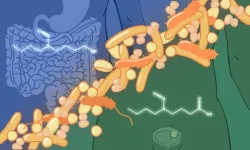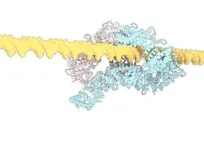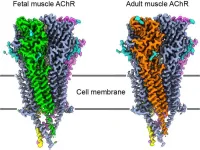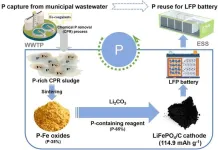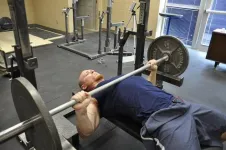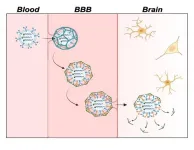(Press-News.org) At any given time, over 10 trillion microbes call our guts their home. From breaking down nutrients in our food to strengthening our immunity against pathogens, these microbes play an essential role in how we interact with the world. This includes – as shown in a new study by EMBL researchers and collaborators at the University of Split, Croatia – the way the body responds to carcinogens and develops cancer.
Carcinogens are chemicals that can cause ordinary cells to transform into cancer cells, giving rise to tumours and cancer. They can be found in a number of places, tobacco smoke being one of the most well-known sources. Researchers have previously found that if mice are exposed to the nitrosamine BBN, one of the chemicals found in tobacco smoke, they reliably develop an aggressive form of bladder cancer. This is therefore used as a common laboratory model of carcinogen-induced cancer.
Janoš Terzić's lab at the University of Split, Croatia, was studying this model when they made a curious observation. If the mice were fed antibiotics, at a dose that kills 99.9% of their gut bacteria, at the same time as they were exposed to BBN the chances of them forming tumours were much lower.
"While 90% of mice exposed to BBN went on to develop bladder tumours, only 10% of those that also received antibiotics did so. This led us to hypothesise that the gut bacteria might be involved in regulating the way BBN is processed in the body," said Blanka Roje, co-first author of the study and PhD student at the Laboratory for Cancer Research, University of Split School of Medicine in Croatia. “I’ll never forget seeing BBN and BCPN bands on thin layer chromatography plates following overnight incubation of bacteria and BBN.”
“The decrease in tumour incidence was so dramatic that at first I doubted the results, thinking we must have made a mistake somewhere in the experiment. Consequently, we repeated the experiment five times before we finally became ‘believers’,” Terzić said. “It was fantastic to realise that with a treatment – in this case, antibiotics – we were able to abolish cancer development.”
While attending a conference at EMBL Heidelberg, Terzić met with Michael Zimmermann, a group leader at EMBL Heidelberg. The Zimmermann group specialises in using high-throughput methods to study gut microbiome functions, focusing mainly on a process called biotransformation. Biotransformation is the ability microorganisms have to alter or break down chemicals in their environment.
The initial meeting gave rise to a fruitful collaboration. The two groups decided to combine their expertise to understand whether and how gut bacteria affected the way the mice responded to the carcinogen. Using a variety of microbiology and molecular biology methods, the researchers discovered that bacteria living in the mouse gut could convert BBN into BCPN. Like BBN, BCPN belongs to a class of compounds called nitrosamines. However, the team found that, unlike BBN, BCPN concentrates in the urinary bladder and triggers tumour formation in a microbiome-dependent manner.
The researchers next studied over 500 isolated and cultured bacteria to identify the specific bacterial species involved in converting BBN to BCPN. "We found 12 species that can carry out this carcinogen biotransformation," said Boyao Zhang, co-first author of the study and former PhD student in the Zimmermann group. "We sequenced them and were surprised to find that many of those species were skin-associated and found at relatively low abundance in the gut. We speculated that there might be some transient transfer of such bacteria from the skin to the gut as a consequence of the animals’ grooming. But it was important to figure out whether these findings would also be true for humans."
Following these initial studies in mice, the scientists used human faecal samples to show that human gut bacteria can also convert BBN to BCPN. As a proof of concept, they showed that if human stool was transplanted into the intestine of a mouse that had no gut microbiome of its own, they could also convert BBN to BCPN.
However, the researchers also observed large individual differences in the ability of the human gut microbiome to metabolise BBN, as well as in the bacterial species involved in the biotransformation. "We think this lays the foundation for further research to see whether a person’s gut microbiome represents a predisposition for chemically induced carcinogenesis and could hence be used to predict the individual risk and potentially prevent cancer development,” said Zimmermann.
“This difference in interindividual microbiota could explain why some people, despite being exposed to potential carcinogens, do not develop cancers while others do,” Terzić added.
Do these findings mean antibiotics can universally prevent cancer? No, of course not, says Zimmermann. "This calls for more studies, including some that we are doing currently, to understand how the microbiome influences the metabolism of different types of carcinogens. It is also important to remember that cancer is a multifactorial disease – there is rarely a single cause."
The study aligns with EMBL's Microbial Ecosystems and Human Ecosystems transversal themes, which were introduced in its 2022-26 Programme, 'Molecules to Ecosystems'. The Microbial Ecosystems theme aims to explore microorganisms and their interactions with each other and with their environments, while the Human Ecosystems theme plans to take advantage of rapidly expanding human datasets to explore the gene–environment interplay and its effects on human phenotypes. Learn more about these research plans here.
END
Gut microbes implicated in bladder cancer
Study shows that gut bacteria can metabolise carcinogens and cause them to accumulate in distant organs, leading to tumour development.
2024-07-31
ELSE PRESS RELEASES FROM THIS DATE:
Trust in physicians and hospitals declined over the course of the COVID-19 pandemic
2024-07-31
BOSTON– A cross-representative survey of adults in the United States showed decreasing levels of trust in physicians and hospitals during the COVID-19 pandemic—and the lower the trust, the less likely an individual was to get vaccinated against SARS-CoV-2 or influenza. The findings come from a survey study of more than 400,000 U.S. adults published in JAMA Network Open by a team co-led by investigators at Massachusetts General Hospital (MGH), a founding member of the Mass General Brigham healthcare system.
“Trust in ...
Unraveling a key junction underlying muscle contraction
2024-07-31
The connections between the nervous system and muscles develop differently across the kingdom of life. It takes newborn humans roughly a year to develop the proper muscular systems that support the ability to walk, while cows can walk mere minutes after birth and run not long after.
University of California San Diego researchers, using powerful new visualization technologies, now have a clear picture of why these two scenarios develop so differently. The results offer new insight into understanding muscle contraction in humans that may help in developing future treatments for muscular diseases.
“In this study we set out to understand ...
New method recovers phosphorus from wastewater to power the future of lithium-iron phosphate batteries
2024-07-31
In a recent study published in Engineering, a research team from the Shenzhen Engineering Research Laboratory for Sludge and Food Waste Treatment and Resource Recovery has introduced a pioneering method to tackle the critical global issue of phosphorus (P) scarcity. Their innovative approach leverages municipal wastewater to produce phosphorus vital for the manufacture of lithium iron phosphate (LiFePO4) batteries, a key component in the rapidly growing electric vehicle market.
As the demand for LiFePO4 batteries ...
SwRI awarded $35.7 million to support cryptologic systems for U.S. Navy
2024-07-31
SAN ANTONIO — July 31, 2024 —Southwest Research Institute will provide engineering and equipment support for advanced cryptologic technology for shipboard and airborne platforms as part of a $35.7 million contract with the U.S. Navy. The five-year contract will deliver services from June 2024 through June 2029, with the option for the U.S. Navy to add $14 million and extend the contract through 2031.
SwRI develops electronic warfare (EW) technology to detect, intercept and disrupt a range of signals on the electromagnetic spectrum, supporting efforts to thwart ...
With biodiversity under threat, scientists suggest the need for a new biorepository—on the moon
2024-07-31
With numerous species facing extinction, an international team of researchers has proposed an innovative solution to protect the planet's biodiversity: a lunar biorepository. This concept, detailed in a recent article in the journal BioScience, is aimed at creating a passive, long-lasting storage facility for cryopreserved samples of Earth's most at-risk animal species.
Led by Dr. Mary Hagedorn of the Smithsonian's National Zoo and Conservation Biology Institute, the team envisions taking advantage of the Moon's naturally cold temperatures, particularly in permanently shadowed regions near the poles, where temperatures remain consistently below –196 degrees ...
Strong El Nino makes European winters easier to forecast
2024-07-31
Heavy rain and flooding in Brazil in November could tell forecasters whether December, January and February in Britain will be cold and dry or mild and wet.
This is because forecasting European winter weather patterns months in advance is made simpler during years of strong El Niño or La Niña events in the tropical Pacific Ocean, a new study has found.
A strong El Nino or La Nina in the Pacific Ocean can bring big changes in temperatures, wind patterns and rainfall patterns to South America. When ...
MD Anderson and collaborators to launch project studying T cells on International Space Station
2024-07-31
HOUSTON ― The University of Texas MD Anderson Cancer Center and collaborators are initiating a research project that will send T cells to the International Space Station (ISS) to study the effects of prolonged microgravity on cell differentiation, activation, memory and exhaustion. These results will be further analyzed on Earth to uncover signaling pathways and identify potential immune targets that can improve treatment strategies for patients with cancer and other diseases.
To accomplish this work, MD Anderson researchers ...
Chameleon testbed secures $12 million in funding for phase 4: Expanding frontiers in computer science research
2024-07-31
Chameleon, led by Senior Scientist Kate Keahey from Argonne National Laboratory, has been a cornerstone of CS research and education for nearly a decade. The platform has served over 10,000 users, contributing to more than 700 research publications. Chameleon has now secured an additional $12 million in funding from the U.S. National Science Foundation (NSF) to roll out its next four-year phase. With this new funding, Chameleon will continue to innovate and support its growing community, enabling groundbreaking discoveries in CS systems research.
ABOUT CHAMELEON: A PLATFORM FOR INNOVATION
Chameleon is a large-scale, deeply reconfigurable experimental ...
For bigger muscles push close to failure, for strength, maybe not
2024-07-31
When performing resistance training such as lifting weights, there’s a lot of interest in how close you push yourself to failure – the point where you can’t do another rep – and how it affects your results.
While research has looked at this concept in different ways, to date, no meta-analysis has explored the pattern (i.e., linear or non-linear) of how the distance from failure (measured by repetitions in reserve) affects changes in muscle strength and size.
As such, it’s ...
Improving Alzheimer’s disease imaging — with fluorescent sensors
2024-07-31
Neurotransmitter levels in the brain can indicate brain health and neurodegenerative diseases like Alzheimer’s. However, the protective blood-brain barrier (BBB) makes delivering fluorescent sensors that can detect these small molecules to the brain difficult. Now, researchers in ACS Central Science demonstrate a way of packaging these sensors for easy passage across the BBB in mice, allowing for improved brain imaging. With further development, the technology could help advance Alzheimer’s disease diagnosis and treatment.
It is common for neurotransmitter levels ...
LAST 30 PRESS RELEASES:
Numbers in our sights affect how we perceive space
SIMJ announces global collaborative book project in commemoration of its 75th anniversary
Air pollution exposure and birth weight
Obstructive sleep apnea risk and mental health conditions among older adults
How talking slows eye movements behind the wheel
The Ceramic Society of Japan’s Oxoate Ceramics Research Association launches new international book project
Heart-brain connection: international study reveals the role of the vagus nerve in keeping the heart young
Researchers identify Rb1 as a predictive biomarker for a new therapeutic strategy in some breast cancers
Survey reveals ethical gaps slowing AI adoption in pediatric surgery
Stimulant ADHD medications work differently than thought
AI overestimates how smart people are, according to HSE economists
HSE researchers create genome-wide map of quadruplexes
Scientists boost cell "powerhouses" to burn more calories
Automatic label checking: The missing step in making reliable medical AI
Low daily alcohol intake linked to 50% heightened mouth cancer risk in India
American Meteorological Society announces Rick Spinrad as 2026 President-Elect
Biomass-based carbon capture spotlighted in newly released global climate webinar recording
Illuminating invisible nano pollutants: advanced bioimaging tracks the full journey of emerging nanoscale contaminants in living systems
How does age affect recovery from spinal cord injury?
Novel AI tool offers prognosis for patients with head and neck cancer
Fathers’ microplastic exposure tied to their children’s metabolic problems
Research validates laboratory model for studying high-grade serous ovarian cancer
SIR 2026 delivers transformative breakthroughs in minimally invasive medicine to improve patient care
Stem Cell Reports most downloaded papers of 2025 highlight the breadth and impact of stem cell research
Oxford-led study estimates NHS spends around 3% of its primary and secondary care budget on the health impacts of heat and cold in England
A researcher’s long quest leads to a smart composite breakthrough
Urban wild bees act as “microbial sensors” of city health.
New study finds where you live affects recovery after a hip fracture
Forecasting the impact of fully automated vehicle adoption on US road traffic injuries
Alcohol-related hospitalizations from 2016 to 2022
[Press-News.org] Gut microbes implicated in bladder cancerStudy shows that gut bacteria can metabolise carcinogens and cause them to accumulate in distant organs, leading to tumour development.
